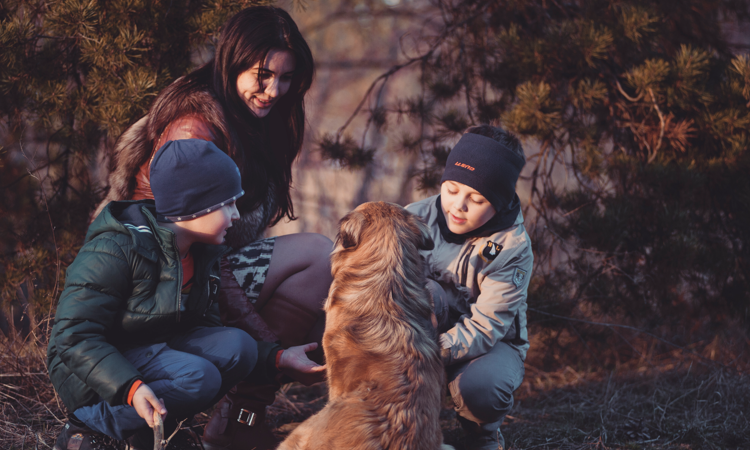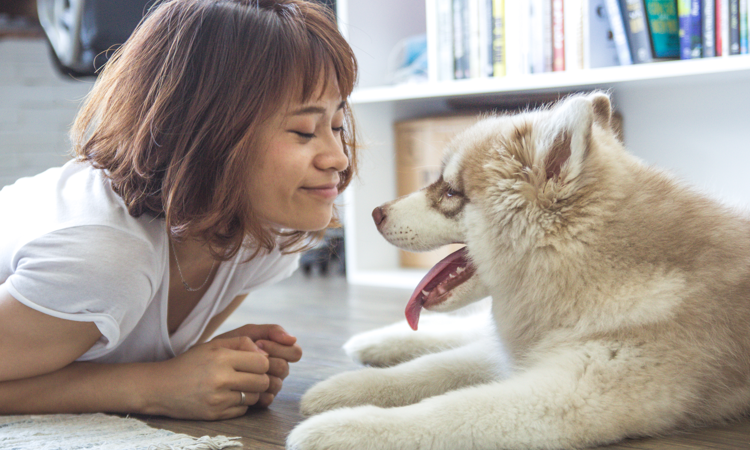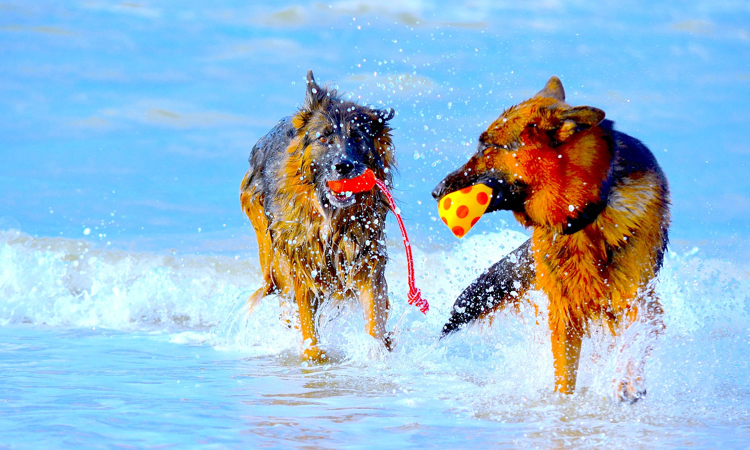Dogs are naturally social animals, as anyone who’s ever taken a dog for walk in a busy park will know, the desire to sniff every bottom and lick every hand can make a quick walk turn into a long outing. Positive socialisation can help your dog grow up to be a well-rounded character, who will enjoy meeting new people, other dogs, and exploring new places, giving them the best chance to have a happy and fun-filled life.
Puppy socialisation needs to start early! Puppies have a socialisation ‘window’ which starts when they’re roughly three weeks old and lasts until they’re about 12 weeks old where they need to meet lots of dogs, people and places, to familiarise them with different situations. However, lack of socialisation or a bad experience can make a dog wary, nervous and even aggressive around other dogs. Here are our top tips to ensure your dog is socialised well.
The importance of socialising your dog

Providing your dog with lots of pleasant encounters from a young age goes a long way to help them become a friendly adult dog. Early experiences count towards the temperament and habits of your dog as they grow up. Spotting a puppy who wasn’t introduced to other dogs from a young age is easy; often they won’t know how to greet another dog, they might struggle to play with other dogs, and can often become scared or aggressive as a result.
When a dog is well socialised they’re relaxed, friendly and can be taken anywhere, even on a family trip to your nearest dog-friendly pub.
Luckily, socialising your dog is fairly easy and can be fun! After all, what other excuse do you have to book in as many people and puppy playdates as possible? Socialising an adult dog can be slightly more tricky but, with patience, is a great way to help an older dog to get more out of life.
5 tips: How to socialise a puppy

1. Start young
Puppies up to 12 weeks old will be excited to meet and greet anyone and everything they come into contact with. After this time, which is often called ‘the socialisation period’, they start to become more wary of new situations, including meeting people and other dogs.
Prior to your puppy’s injections try to get them to meet as many people as possible and have lots of experiences, such as a trip in the car, seeing the hoover and dealing with other noises, sights and smells they’ll come across in their everyday lives.
If you have a friend or family member who has another dog that you know has been vaccinated you can organise an indoor playdate. The more dogs and people your puppy meets at this stage, the more confident they will be around other dogs and people later in life.
2. Meet people and dogs from all walks of life
Before your puppy is 12 weeks old, give them a varied experience of people and other dogs. From big dogs to small dogs, yappy dogs and quiet dogs, the more variations they can meet the more accepting they will be of different dog personalities later in life.
This goes for people too. Try to get your puppy to meet adults, children and babies as well as people of different heights and races. Many dogs develop irrational fears to men with beards, or small children simply because they weren’t broadly socialised enough at a young age.
3. Go slowly
It’s exciting to have a new puppy and you’ll no doubt want to show them off as much as you can, giving them as many experiences of being loved and admired everywhere they go. It’s important to be careful not to overwhelm them. Start by socialising your puppy for five or 10 minutes at a time, then allow them to relax and be alone. The more adept they become at playing nicely, the longer you can let them spend with other people or pets.
4. Socialising shy puppies
Like humans, dogs have different personalities. Some puppies will be naturally shy from birth and will therefore find socialisation more difficult. If your puppy is particularly nervous, introduce new situations, objects and people very slowly. Ask strangers or family members to not stare or try to hug or pick up your puppy. Instead, suggest that they can offer your pup small treats or simply ignore your puppy until it builds up enough courage to take the initiative and go to them.
5. Get to know your puppy’s behaviour
Helping create positive experiences is one side of the socialisation coin; the other is trying to avoid and relieve any negative experiences. Puppies can get themselves into scraps before they’ve learned the ropes. They can be annoying to older dogs and can get under the feet of people; all of which can lead to the puppy getting told off or hurt.
Keep an eye on your puppy and learn what behavioural issues they might need you to help them avoid. For example, are they likely to be too curious with an older dog who just wants to be left alone to sleep? Your puppy might think the older dog’s telling-off barks or growls are part of a game and they may need you to step in.
Never drag your puppy to someone they seem wary of or pass them to someone to carry if they don’t approach them first. Puppies should be allowed to approach and back away from any situation that makes them unhappy.
3 tips: How to socialise your adult dog

Dogs need to be regularly socialised as an ongoing practice at all stages of their life. With only a crucial nine-week window when puppies are more comfortable meeting new people and dogs, some pups can miss out on this crucial socialisation period. There can be many reasons for this, perhaps they were ill, had to be kept inside or just didn’t have the chance to meet as many dogs as they needed to. In any case, it’s never too late to help your adult dog to become more social, check out our tips below.
1. Introduce other dogs slowly
Whether your dog is nervous or just isn’t sure how to socialise around other dogs, you need to begin reintroducing them on walks. If your dog is friendly, give them a minute to say hello to another doggy friend then praise and reward them quickly for their good behaviour.
If your dog barks or is aggressive or scared of other dogs, practice being near other dogs but from a safe distance. Perhaps you could walk past a dog on the other side of the road or other side of the field. If your dog barks or becomes anxious, ignore this behaviour or try a distraction technique such as walking the other way. Telling them off at this stage will only increase their fear of the situation and can lead to aggressive behaviour. Try to behave as calmly as normally as you can, since dogs pick up on our signals; the more anxious you seem, the more your dog will think the situation requires aggression.
2. Introduce your dog to new experiences
New experiences, whether that’s a new park, route or environment, can be daunting for an under-socialised dog. Try to get your dog to visit one new place at least every day, even if it’s only for five minutes at a time. During that time, give your dog lots of praise and treats. Make the experience as fun as possible – why not bring along your dog’s favourite game or toy and they’ll soon build up new positive associations, realising that it’s a safe and even fun place to hang out.
3. Consider dog training classes
If your dog continues to be timid or aggressive, dog training classes can be a great way to introduce them to other dogs in a safe environment. Let the trainer know about your dog’s problems prior to the class and ensure you always have their collar and lead for safety if required. The Good Citizen Dog Scheme can be a great place to start for older dogs looking to learn how to socialise.
Has your dog always been social butterfly from their first pawsteps, or did they need a little extra encouragement? We’d love to hear all about your experiences. Tell us your stories on Facebook, Twitter or post in the comments below.